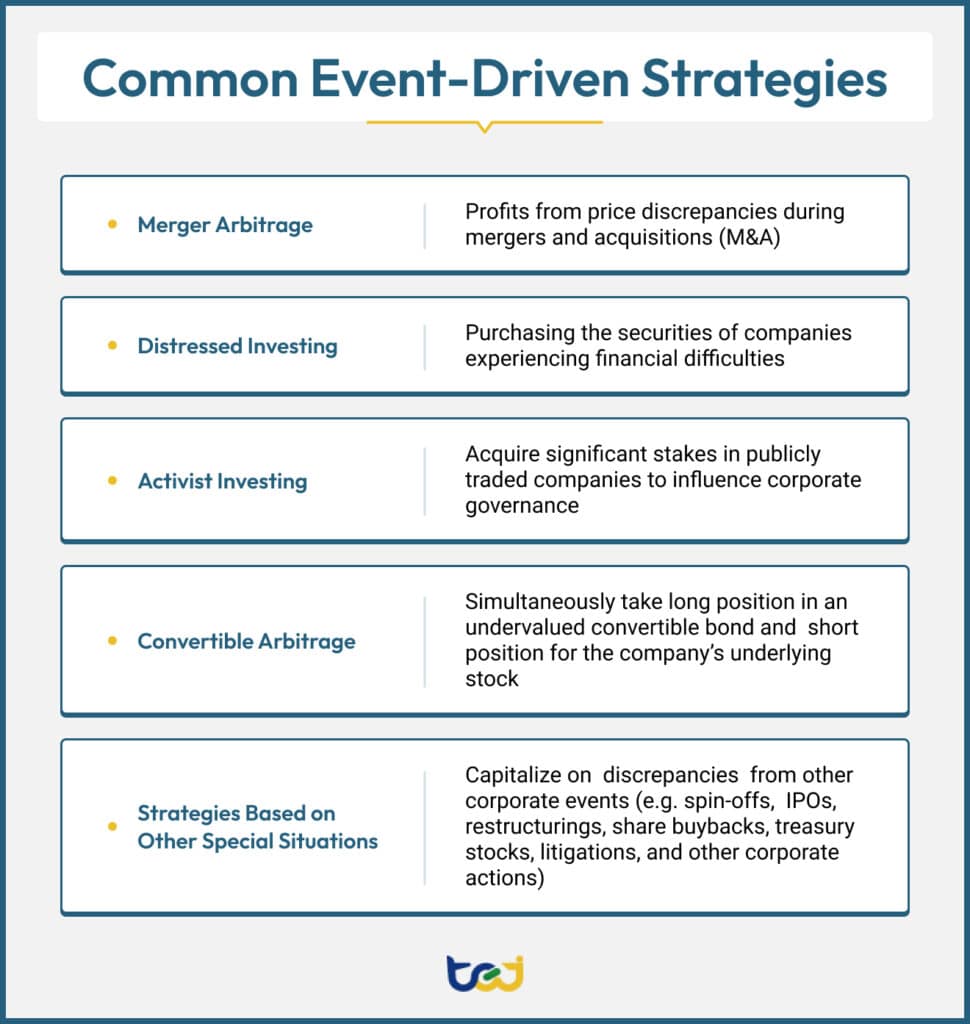
Table of Contents
Event-driven investing is an investment strategy that capitalizes on pricing inefficiencies caused by significant corporate events, such as mergers, acquisitions, restructurings, or bankruptcies. These events often cause volatility and temporary mispricing in securities, presenting profit opportunities as the market takes time to digest the new corporate announcement.
However, it requires careful analysis and execution for high returns. Investors who leverage event-driven trading strategies will proactively analyze the situation to predict the stock’s future performance and position their investments according to the regulatory environments, potential synergies, and financial restructuring outcomes.
Event-driven trading strategies can be further differentiated based on the event they focus on. This section will delve into some of the most common event-driven strategy examples to help you understand them.

Merger arbitrage aims to profit from price discrepancies during mergers and acquisitions (M&A). When a merger is announced, the target company’s stock price typically rises but remains below the proposed acquisition price due to deal uncertainty. Merger arbitrageurs exploit this gap by purchasing shares of the target company, anticipating a profit when the deal successfully closes.
During the process, analysts thoroughly research market data to assess the financial stability of the involved companies, regulatory hurdles, and the likelihood of shareholder approval. They will also calculate the arbitrage spread—the difference between the current stock price and the acquisition price—which reflects the market’s view of the deal’s probability and timeline.
Once ready to execute this strategy, the investor will take a long position in the target company’s stock to bank on the merger completed at the agreed price. They will also continue to manage the position by monitoring developments, such as regulatory reviews and market sentiment to adjust their investment portfolio accordingly.
While successful mergers can yield attractive profits, the main risks of deal failures could cause significant losses as the target’s stock price reverts to pre-merger levels.
Distressed investing involves purchasing the securities of companies experiencing financial difficulties. These securities (often corporate bonds or loans) will trade at steep discounts due to the company’s insolvency or default on debt payments.
Investors target these undervalued assets intending to generate high returns through restructuring efforts. Thus, the success of this strategy relies on the company’s potential for recovery. Key considerations include the quality of the company’s assets, its competitive position, and the viability of financial or operational turnaround under current market conditions.
The potential rewards can be significant if the company successfully recovers from financial distress, as returns often stem from debt-to-equity conversions or improved asset valuations. Nevertheless, this strategy poses a challenge due to the lack of reliable information, as distressed companies are often less transparent, making it difficult to assess investment value. To combat this issue, investors may rely on alternative data rather than conventional reports to research these companies.
Another challenge of distressed investing is the intense competition from other investors, particularly those who have invested earlier and are positioned to acquire a majority stake during bankruptcies. This could raise the cost of acquiring distressed assets and limit potential returns.
Activist investing is a strategy where investors acquire significant stakes in publicly traded companies to influence corporate governance and strategic direction. These investors target underperforming or undervalued firms, aiming to implement changes that enhance shareholder value and improve the company’s performance for greater profits.
Activist investors often engage with company management using various approaches. For instance, proxy contests allow them to propose alternatives to the board of directors, while board nominations enable them to influence decisions directly.
These investors may also offer formal suggestions for operational or governance improvements through shareholder proposals. In turn, these efforts may lead to changes such as divesting non-core assets, restructuring capital allocation, pushing ESG policies, or replacing inefficient management teams.
Activist investing can drive substantial benefits, including improved financial performance, increased stock prices, and enhanced corporate governance practices. However, their interventions can also create tension with existing leadership, so due diligence and a deep understanding of the company’s dynamics are required to ensure a smooth transition.
Convertible arbitrage is a long-short investing strategy that involves taking a long position in an undervalued convertible bond and simultaneously shorting the company’s underlying stock to capitalize on the pricing discrepancies between them.
If the stock price declines, the investor profits from the short position which neutralizes losses by capturing the convertible bond yield. Conversely, if the stock price increases, the investor can convert the bond into stock and sell it at the market price, potentially offsetting losses from the short position.
With this market-neutral approach, investors aim to generate consistent returns regardless of the stock’s direction by carefully balancing the hedge ratio, which is determined by the convertible bond’s delta (price sensitivity). Still, this strategy relies on comprehensive risk management from rigorous quantitative data analysis to ensure profitability.
Other irregular, one-time corporate events that could temporarily disrupt a company’s valuation or market dynamics include spin-offs, initial public offerings (IPOs), restructurings, share buybacks, treasury stocks, litigations, and other corporate actions.
Each of these events presents opportunities for investors to capitalize on inefficiencies in market pricing. For example, a positive event like the announcement of a share buyback may boost a company’s stock price in the short term, allowing investors to profit from anticipated upward trends.
On the other hand, negative events, such as litigation, might temporarily depress the stock price. This allows investors to acquire stocks at a lower price and profit from it when the issue is eventually resolved.
No matter the event, investors must weigh the security’s value by considering factors like the permanence of the situation’s impact and market conditions (such as volatility or liquidity). This can help investors create an effective quantitative strategy for event-driven investing.
Moreover, it is also important to use comprehensive and accurate data for event-driven investing. In particular, TEJ’s database compiles information on Taiwan’s corporate action and treasury stock. By analyzing this data, investors can identify how events, like IPOs, stock buybacks, fundraising, and more, affect a company’s stock price. As such, this allows them to capitalize on these events to create better investment strategies and maximize their returns.
This section will explore a few real-life cases of event-driven investing to showcase the potential of this strategy.
In 2017, the Disney-Fox acquisition deal created a notable case of merger arbitrage. Investors identified an undervaluation in Fox’s shares during the early stages of the deal when there was market uncertainty surrounding the transaction. By purchasing these shares at a discount, the investors gained profit once the merger terms were finalized at $71.3 billion and increased the prices of Fox’s shares by 39.7%.
Charlie Munger’s Tenneco investment in 2001 is an example of how distressed investing can be profitable. At the time, Tenneco, an auto parts manufacturer, faced severe financial difficulties due to declining operating performance and mounting debt. Munger saw an opportunity in the company’s undervalued stock and bonds. He purchased shares trading at approximately $1.50 to $2.00 and bonds yielding an extraordinary 35% to maturity.
Tenneco managed to restructure its operations and recover profitability, reducing the perceived bankruptcy risk. This turnaround sent its stock soaring to about $15 per share and returned its bonds to par value, allowing Munger to make approximately $80 million in profits.
Starboard’s investment in Darden highlights how activist investing can influence corporate strategy for operational improvements and deliver substantial returns. In 2014, Starboard took a 5.6% stake in Darden Restaurants and replaced 12 out of 14 board members.
Consequently, Starboard pushed for significant changes in Darden, which included cost-cutting measures, streamlining the Olive Garden menu, and implementing a sale-leaseback strategy for real estate assets. These actions revitalized operations, allowing the earnings per share to rise by 22% in the following year.
Event-driven investments offer profitable opportunities but require careful execution. Hence, high-quality data becomes essential for identifying opportunities and making informed investment decisions to generate returns.
As a reliable financial and economic data provider, TEJ offers comprehensive solutions tailored for event-driven strategies. Our dataset encompasses crucial information, including treasury stock transactions, dividend policies, corporate mergers, spin-offs, equity changes, and more, allowing investors to create precise strategies targeted at the Taiwanese stock market.
Besides, established upon the Point in Time Architecture (PTA) approach, TEJ’s database preserves the corporate event’s full chronology, tracking each stage from announcement to completion. TEJ also retains accurate information about the dates and processes of every event. As such, investors can implement rigorous analysis for effective event-driven strategies.
Additionally, TEJ ensures that all data is updated in a timely manner, allowing investors to identify market fluctuations and capture opportunities. With these prompt updates, investors can also adjust their investment strategies accordingly to ensure their portfolios are up-to-date.
Ready to get started? Explore TEJ’s event-driven data solutions today and refine your investment approach!